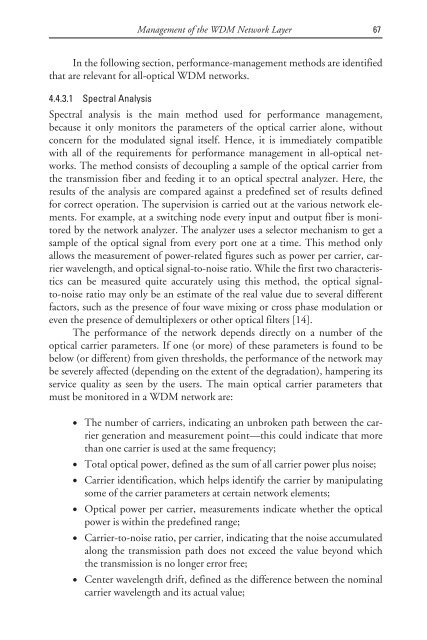deploying and managing ip over wdm networks - Index of
deploying and managing ip over wdm networks - Index of
deploying and managing ip over wdm networks - Index of
Create successful ePaper yourself
Turn your PDF publications into a flip-book with our unique Google optimized e-Paper software.
Management <strong>of</strong> the WDM Network Layer 67<br />
In the following section, performance-management methods are identified<br />
that are relevant for all-optical WDM <strong>networks</strong>.<br />
4.4.3.1 Spectral Analysis<br />
Spectral analysis is the main method used for performance management,<br />
because it only monitors the parameters <strong>of</strong> the optical carrier alone, without<br />
concern for the modulated signal itself. Hence, it is immediately compatible<br />
with all <strong>of</strong> the requirements for performance management in all-optical <strong>networks</strong>.<br />
The method consists <strong>of</strong> decoupling a sample <strong>of</strong> the optical carrier from<br />
the transmission fiber <strong>and</strong> feeding it to an optical spectral analyzer. Here, the<br />
results <strong>of</strong> the analysis are compared against a predefined set <strong>of</strong> results defined<br />
for correct operation. The supervision is carried out at the various network elements.<br />
For example, at a switching node every input <strong>and</strong> output fiber is monitored<br />
by the network analyzer. The analyzer uses a selector mechanism to get a<br />
sample <strong>of</strong> the optical signal from every port one at a time. This method only<br />
allows the measurement <strong>of</strong> power-related figures such as power per carrier, carrier<br />
wavelength, <strong>and</strong> optical signal-to-noise ratio. While the first two characteristics<br />
can be measured quite accurately using this method, the optical signalto-noise<br />
ratio may only be an estimate <strong>of</strong> the real value due to several different<br />
factors, such as the presence <strong>of</strong> four wave mixing or cross phase modulation or<br />
even the presence <strong>of</strong> demult<strong>ip</strong>lexers or other optical filters [14].<br />
The performance <strong>of</strong> the network depends directly on a number <strong>of</strong> the<br />
optical carrier parameters. If one (or more) <strong>of</strong> these parameters is found to be<br />
below (or different) from given thresholds, the performance <strong>of</strong> the network may<br />
be severely affected (depending on the extent <strong>of</strong> the degradation), hampering its<br />
service quality as seen by the users. The main optical carrier parameters that<br />
must be monitored in a WDM network are:<br />
• The number <strong>of</strong> carriers, indicating an unbroken path between the carrier<br />
generation <strong>and</strong> measurement point—this could indicate that more<br />
than one carrier is used at the same frequency;<br />
• Total optical power, defined as the sum <strong>of</strong> all carrier power plus noise;<br />
• Carrier identification, which helps identify the carrier by man<strong>ip</strong>ulating<br />
some <strong>of</strong> the carrier parameters at certain network elements;<br />
• Optical power per carrier, measurements indicate whether the optical<br />
power is within the predefined range;<br />
• Carrier-to-noise ratio, per carrier, indicating that the noise accumulated<br />
along the transmission path does not exceed the value beyond which<br />
the transmission is no longer error free;<br />
• Center wavelength drift, defined as the difference between the nominal<br />
carrier wavelength <strong>and</strong> its actual value;


